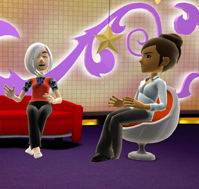What's next for Kinect? Next week, avatar meetings; Later, PC and phone integration

During this week's Microsoft Research Faculty Summit, Microsoft Chief Research and Strategy Officer Craig Mundie confirmed what was already largely suspected: Avatar Kinect will be available worldwide as of next week.
Update (July 25): Microsoft has made Avatar Kinect available for download. It is free for all Xbox Live Silver and Gold members through September 8 (and remains free for Gold members after that time).
Mundie also shared more about some of the ways Microsoft is tweaking Kinect and Avatar Kinect to make them more attractive to business users in both the nearer and longer terms. Mundie made it plain that Microsoft envisions a day when Kinect camera/sensors could be embedded in PCs and phones.

Mundie noted during his Faculty Summit remarks that Avatar Kinect will be available free to Xbox Live Gold users. "(T)he V.1 (Avatar Kinect) product is going to be out there in the next few weeks, and if you're an Xbox LIVE Gold subscriber, you can essentially have multiparty meetings with your friends anywhere in the world, up to eight people at a time, as your avatars," Mundie told conference attendees.
But longer term, business users conducting "real meetings" are another target audience for Avatar Kinect. Right out of the gate, it will improve on the existing videoconferencing experience, Mundie said. From a transcript of his remarks:
"There's a number of things you can do with the Avatar Kinect. One of them is, it has a Kinect videoconference facility. And what's interesting about it is that, while it's just more traditional videoconferencing, the camera tracks you as you move around. So, you're now sitting some significant distance away from the screen. So, many of the problems that you have with traditional sort of PC-based videoconferencing, where when you're so close the angular displacement of the camera from where your gaze is gives you that very weird sensation. When you're far back, that angle becomes just a couple of degrees, and the gaze problem is sort of automatically corrected."
But Microsoft isn't stopping there. Officials believe that to be accepted in business settings, the Avatar Kinect avatars will need to morph a bit to be "more photo real," Mundie said. Microsoft also will need to enable the Kinect to track hands and even finger movements -- something the device doesn't do now -- though something that some Kinect hackers inside and outside of Microsoft already have working.
Here's what Mundie told the academics attending this week's conference about Kinect and hand tracking:
"Another thing we're working on, and we did some work in Avatar Kinect, is tracking the hands. In the major games, we stopped at the wrist, because at that distance, there's not enough sensor resolution to do the individual digits of your hand. But, when you get a little up close, and you're not moving so fast, we can basically even get down to the hands and finger movements. So, I think all of these things will prove, obviously, the silicon environment will improve the sensor technology, and we'll keep moving that along, too."
Microsoft also is allowing users to create custom "sets," or stages, for their kinds of meetings. The initial Avatar Kinect release will provide users with 16 pre-made sets, ranging from tailgate parties to the TV interview set, Mundie noted. "But, obviously if this is going to become broader, or be applied in ultimately more commercial applications, you don't want to just go look at the sets that we have, you want to make your own," he said.
At that point, there was some kind of a demo during the Faculty Summit, the content of which Microsoft edited out, the transcript notes. But it sounds from hints below that in the transcript that he demonstrated a scenario involving Kinect's sensors, voice, gesture and touch technologies in a medical setting.
In the longer term, Microsoft execs are thinking that the Kinect sensor won't necessarily need to remain a separate, standalone device. Mundie offered no timeframe as to when that might happen, but did say he could see the Kinect sensor technology finding its way into cell phones or laptops. From the transcript:
"(T)here's no reason to think that these won't go through the same progression that we've seen with other sensor technologies. I could dream about a day where anywhere today that you have a camera, which is the back of your cell phone, or the bezel of your laptop, there's no reason to think that over time that camera shouldn't be this kind of camera. And there's obviously a lot of work yet to go to produce that level of miniaturization, but I don't see any fundamental reason to think that wouldn't happen. And therefore many of these things I think will be available in the mobile environment in one form or another."
I'd been wondering when Microsoft might incorporate Kinect sensors into PCs and phones. I'm also wondering how Kinect and Avatar Kinect will dovetail with Skype and Lync, Microsoft's unified messaging product. Thoughts?